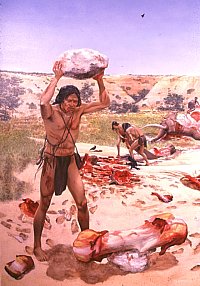
Butchering a Mammoth, 1. A man hoists
a boulder over his head to crack open the humerus (upper
front leg bone) of a mammoth (Ice-Age elephant). The
resulting bone fragments will be used as butchering
tools. Behind him several men drag a severed lower leg
to one side.
|
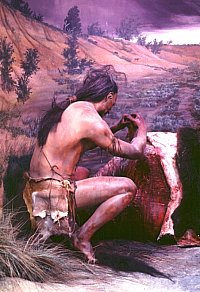
Butchering a Bison, 1. A hunter
begins to carve meat off the hindquarter of a partially
skinned bison (buffalo). This scene combines a sculpture
by Mike O'Brien, with a stuffed bison, and a background
scene painted by Nola Davis.
|
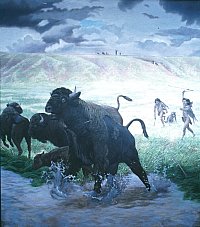
Archaic hunters spring up from the
grass to hurl darts with atlatls at bison at the lake's
edge. The hunters disguised themselves as wolves and
slowly creeped closer before springing. On the horizon
family members watch the scene hoping for a successful
hunt.
|
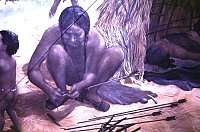
Camp on the Plains, 1. A hunter
uses sinew to bind an arrowhead to an arrow shaft.
|
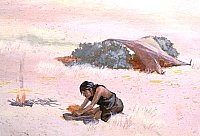
Making flour. Woman grinds seeds
into flour using a metate, a trough-shaped grinding
stone.
|
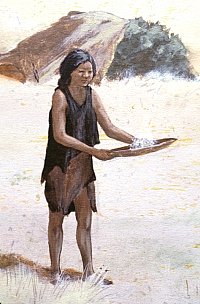
Winnowing seeds, 2. Close up of woman
winnowing grass seeds using a finely woven tray. Although
tiny, grass seeds are highly nutritious and seasonally
abundant, if troublesome to clean.
|
|
The murals and dioramas created for the Lubbock
Lake Landmark by artists Nola Davis and Mike O'Brien of the
Texas Parks and Wildlife Department (TPWD) provide vivid depictions
of prehistoric life based on archeological evidence. The most
spectacular pieces are the life-sized sculptures of Ice-Age
animals created by O'Brien and other artists that grace the
landscape around the interpretive center. Walking up to these
huge beasts really gives you an appreciation for the earliest
Paleoindian hunters who crept around Yellowhouse Draw waiting
for an opportunity to hurl their puny spears at such formidable
prey. Big Game Hunters, indeed!
All of the images below are details of larger
murals and dioramas. The titles and descriptions used here
were coined just for this web exhibit. At the Lubbock Lake
Landmark Interpretive Center you can see the complete murals
and dioramas as they were intended to be shown.
The details shown in these reconstructions are
based carefully on archeological research and on other sources
of information. Dr. Eileen Johnson and her staff at the Lubbock
Lake Landmark provided the TPWD artists with detailed descriptions
of actual archeological deposits from which the scenes were
inferred. Other details are based on early historic accounts,
recorded ethnographic observations, and environmental and
climatic data.
Butchering a Mammoth, 2. A older man and
two women butcher an Ice-Age elephant. Experimental work suggests
that an efficient work group could have carved the beast into
manageable pieces in just one day. Many more days work would
have been required to dry the meat and prepare the hide.
Butchering a Bison, 2. A temporary camp
on the Llano Estacado near where a bison has been killed.
Strips of meat hang to dry on a wooden-pole framework. In
the foreground two women carry long bones upslope to the nearby
camp to extract the marrow for a delicious meal.
Wolves in Disguise, 2. Archaic hunters
hurling darts using atlatls (spear-throwers). The hunters
wear wolf skin disguises so they could creep close enough
to their prey for a kill.

Camp on the Plains, 2. A small band of
hunters and gatherers relaxes around a typical camp on the
Plains, ca. A.D. 1200; in the background bison meat is drying.
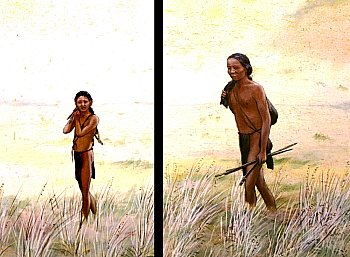
Successful hunt. Father and son return
from a successful hunt carrying small game. This scene is
set in the Middle ate Archaic period, a time when the atlatl
the man carries in his hand was still in use.
On the Move. A small line of travelers
move in search of a new camp. Dogs equipped with travois (carrying
frames) drag many supplies, but each traveler, large and small,
carries something. This scene is set in the early 1500s just
before the introduction of the horse fundamentally changed
life on the Plains.
|
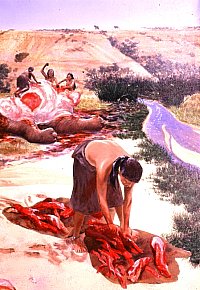
Butchering a Mammoth, 3. A woman
cuts strips of elephant meat on a hide, perhaps to be
carried elsewhere for dinner. In the background, the
beast is being carved up.
Click images to enlarge
|
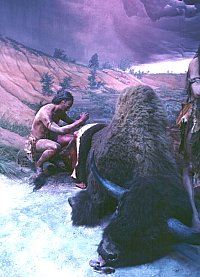
Butchering a Bison, 3. Another view
of a hunter beginning to carve meat off the hindquarter
of a partially skinned bison (buffalo). This scene combines
a sculpture by Mike O'Brien, with a stuffed bison, and
a background scene painted by Nola Davis.
|
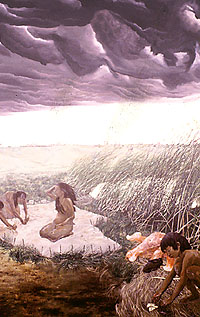
Summer Storm. This scene from a
larger mural depicts activities along the marshy edge
of Lubbock Lake just before a summer storm hits. A woman
looks up from scraping a buffalo hide. A boy places
bison teeth side-by-side in a small pile. Behind him
are the butchered bones of an Ice-Age bison.
|
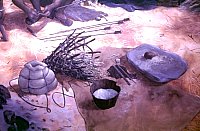
Camp on the Plains, 3. Detail of
camp scene, ca. A.D. 1200.
|
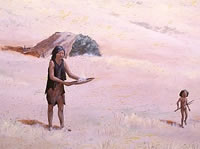
Winnowing seeds, 1. Woman separates
grass seeds from the chaff as her young daughter plays
nearby.
|
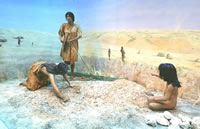
Preparing to Bake. These women are creating
an earth oven in which they will bake roots for several
days. A pit is dug, rocks are gathered (which will become
the heating element), and green vegetation is piled
up. The earth oven, when completed, will have multiple
layers (from bottom to top): coals, hot rocks, green
plants, roots, more green plants, and then a thick cap
of earth.
|
|